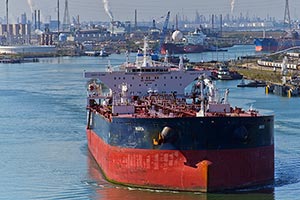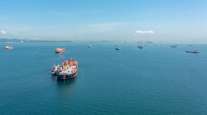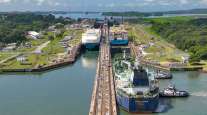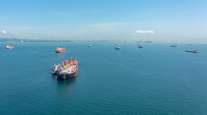Panama Canal Growth Pushes Texas Ports to Improve

The Panama Canal's recent expansion will create economic opportunities for South Texas but also pressures ports to step up improvements to their infrastructure, a panel of transportation industry experts said Aug. 18.
The Port of Corpus Christi has undergone a variety of major improvements since 2008, the year drilling began in the Eagle Ford Shale energy play. Port officials said during a workshop at the Congressman Solomon P. Ortiz International Center that the trend would likely continue, perhaps even accelerate, now that larger ships have a quicker path between the Atlantic and Pacific oceans.
The one-day workshop, titled "Freight: Keep It Moving," challenged transportation industry leaders and supply chain experts on how to come up with more efficient ways move goods, such as liquefied natural gas, crude oil and materials used to make plastics, pipe and steel.
Vessel traffic at the port is down from that of previous years; a total of 3,615 ships sailed through the port between January and July, compared with 4,517 during the same period in 2015. Yet, the weight of their shipments has continually climbed, leading port officials to believe larger ships are being used to transport goods.
RELATED: Dredging makes slow, uneven progress on East Coast to welcome bigger ships
The trend will continue — in Corpus Christi and ports on the Gulf Coast — as global competition increases, said Kurt Nagle, CEO of the American Association of Port Authorities.
A recent survey by the agency said Texas ports and their private-sector partners are planning nearly $48 billion in capital investments in the next five years to handle the expected growth of cargo.
"The role played by American ports is more critical than ever to keep freight moving," Nagle said.
The effort to transform the 102-year-old Panama Canal wrapped up in June at a cost of $5.4 billion. The 10-year-long project called for a new set of locks that now permits ships, known as neo-Panamax class and carrying up to 14,000 containers, to sail through. Many of those vessels undoubtedly will end up at Gulf Coast ports that are equipped to handle them.
John LaRue, the port's executive director, said port officials have been working to find funding sources to help pay for plans to widen the Corpus Christi Ship Channel by 530 feet from Port Aransas to the Harbor Bridge. They also want to deepen and widen its channel to 52 feet from its current depth of 45 feet. Congress authorized the project in 2007 and 2014, but the port does not have the estimated $300 million needed to do the work.
LaRue said the improvements would help the port handle growth and make it safer for ships passing through.
Panelists also generally agreed that the long-discussed Interstate 69 improvement plan would complement, even enhance, international trade at the Texas-Mexico border.
The Texas Department of Transportation has committed more than $600 million to the project, which aims to raise existing roads to interstate highway standards.
"If we don't have a way to move [goods] through our ports ... to market, we die," Nueces County Judge Loyd Neal said.
Corpus Christi's port, the nation's sixth-largest port based on tonnage, expects to attract $40 billion in direct investment to the Coastal Bend Region over the next 10 years. It has been working to grow and improve its local infrastructure in anticipation of that influx, LaRue said.
This year, the port was one of nine Texas ports to qualify for funding from the Texas Transportation Commission. Its share was $3.3 million, which is being used for work along the Joe Fulton International Trade Corridor.
The port is in the final stages of a $48 million multiphase improvement of its railroad system. It was paid for through a combination of funding sources, including money from the Texas Department of Transportation and a $10 million federal Transportation Investment Generating Economic Recovery, or TIGER, discretionary grant.
"There's a lot of positives here, both at this port and in this region," LaRue said. "We know the growth is coming. We just have to continue preparing for it."




